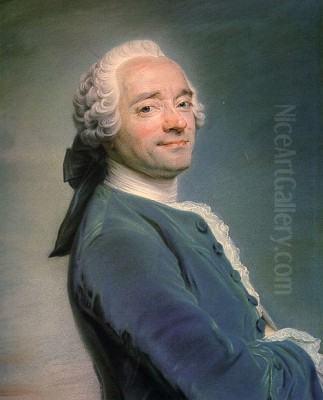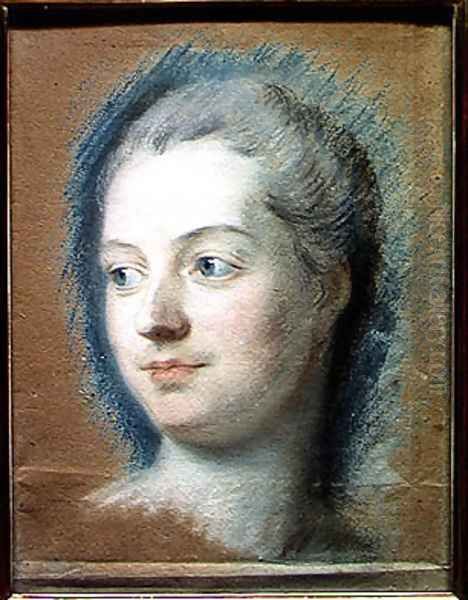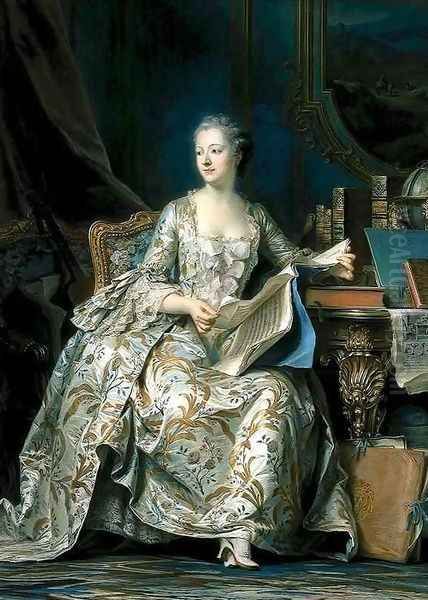
Maurice Quentin de La Tour stands as one of the towering figures of French Rococo portraiture. Living from 1704 to 1788, he navigated the height of the 18th century, capturing the likenesses and spirits of French aristocracy, Enlightenment thinkers, and fellow artists with unparalleled skill in the medium of pastel. Born in Saint-Quentin, France, La Tour became synonymous with a style that was both exquisitely refined and startlingly immediate, securing his place not only as a preeminent artist but also as a respected figure in French society.
Early Life and Artistic Formation
Maurice Quentin de La Tour was born on September 5, 1704, in the Picardy town of Saint-Quentin in northern France. From an early age, he displayed a clear aptitude for drawing and painting. However, his artistic inclinations were not initially supported by his father, who perhaps envisioned a more conventional career path for his son. Despite this lack of paternal encouragement, the young La Tour remained steadfast in his ambition to pursue art.
His formal training began in Paris, where he studied under the Flemish painter Jacques Spoede. This initial instruction provided him with foundational skills. Seeking broader experience, La Tour also spent time training in the cities of Rheims and Cambrai. These formative years exposed him to various artistic currents and helped hone his technical abilities. He eventually returned to Paris, the undisputed center of the French art world, to establish his career.
A significant influence on La Tour's developing style was the Venetian pastelist Rosalba Carriera. Carriera's work was immensely popular across Europe, and her delicate yet lively pastel portraits set a new standard. La Tour absorbed her techniques, particularly the use of soft pastels to achieve subtle gradations of tone and texture, a method that was becoming highly fashionable among the upper echelons of society. Around 1727, La Tour settled permanently in Paris, deciding to specialize almost exclusively in pastel portraiture, a medium perfectly suited to his talent for capturing fleeting expressions and the nuances of personality.
Rise to Prominence: The Paris Salon

The Paris Salon, the official art exhibition of the Académie Royale de Peinture et de Sculpture (Royal Academy of Painting and Sculpture), was the premier venue for artists to display their work and gain recognition. La Tour made his initial mark at the Salon, possibly as early as 1727 with a portrait of the philosopher Voltaire, signaling the beginning of a long and successful career tied to this institution.
His major breakthrough came at the Salon of 1737. In a remarkable display of productivity and skill, he exhibited an astonishing group of around 150 portraits. This exhibition was a triumph, showcasing his mastery of the pastel medium and his ability to capture the likeness and character of his sitters with uncanny accuracy and vivacity. Among the notable works displayed were portraits of Madame Boucher, wife of the prominent painter François Boucher, and a compelling self-portrait.
The success of the 1737 Salon firmly established La Tour's reputation. Critics and the public alike lauded his work for its refined technique, delicate execution, and the sense of life he imparted to his subjects. From this point forward, La Tour became a regular and highly anticipated exhibitor at the Salon for nearly four decades. His submissions consistently drew crowds and cemented his status as the leading pastel portraitist in France, sought after by the most influential figures of the era.
Royal Patronage and Courtly Success
La Tour's growing fame soon attracted the attention of the highest circles of French society, including the royal court. In 1746, his artistic achievements were formally recognized when he was accepted as a full member of the prestigious Royal Academy of Painting and Sculpture. This membership not only conferred significant prestige but also provided further opportunities for high-profile commissions.
The pinnacle of his official recognition arrived in 1750 when he was appointed Peintre du Roi, or Painter to the King. This esteemed position solidified his status within the artistic hierarchy and brought him into close contact with the French monarchy. He held this title until 1773, during which time he created portraits of King Louis XV himself, capturing the monarch's regal bearing with his characteristic blend of formality and psychological insight.

Perhaps his most famous royal connection was with Madame de Pompadour, the influential mistress and trusted friend of Louis XV. A major patron of the arts, Pompadour commissioned several portraits from La Tour. His depictions of her are among his most celebrated works, showcasing not only her elegance and intelligence but also hinting at her complex role at court. The most renowned of these, a large full-length portrait showing her surrounded by symbols of her artistic and intellectual interests, is now a treasure of the Louvre Museum in Paris. These royal commissions underscored La Tour's preeminence in the field of portraiture.
The Art of Pastel: Style and Technique
Maurice Quentin de La Tour's name is inextricably linked with the art of pastel. He elevated this medium to new heights, demonstrating its potential for both intricate detail and broad, expressive effects. His style is firmly rooted in the Rococo aesthetic, characterized by elegance, charm, and a focus on the refined aspects of life. However, La Tour infused this elegance with a remarkable degree of realism and psychological depth.
He possessed an extraordinary ability to capture not just a physical likeness, but the very essence of his sitter's personality – their intelligence, wit, charm, or melancholy. His portraits feel alive, often catching subjects in seemingly spontaneous moments, with subtle smiles or direct gazes that engage the viewer. This immediacy was achieved through his masterful handling of pastel sticks, using delicate layers of color, subtle blending, and precise strokes to render textures like silk, lace, powdered hair, and, most importantly, the softness of skin and the sparkle of an eye.
While influenced by Rosalba Carriera, La Tour developed his own distinct approach. His preparatory studies, many preserved today, reveal his meticulous process, often working out details of expression and pose before committing to the final work. His finished portraits, such as the insightful depiction of fellow artist Jean Restout or the commanding Portrait of Gabriel Bernard de Rieux, demonstrate a technical virtuosity that few contemporaries could match. He captured the surface brilliance demanded by his aristocratic clientele while simultaneously revealing the inner life of the individual.
A Circle of Contemporaries: Interactions and Rivalries
During his long career, La Tour moved within a vibrant artistic and intellectual milieu. His sitters included some of the most prominent figures of the French Enlightenment, such as the philosophers Voltaire and Jean-Jacques Rousseau, and the mathematician and encyclopedist Jean le Rond d'Alembert. His portraits of these thinkers provide invaluable visual records of the intellectual giants of the age.

He naturally interacted with numerous fellow artists. His relationship with François Boucher, a leading Rococo painter, was multifaceted; La Tour painted Boucher's wife, and both artists enjoyed the patronage of Madame de Pompadour. La Tour also collaborated, in a sense, with artists like Carle Van Loo, another prominent court painter, as they both contributed to the visual representation of the royal circle, particularly Pompadour.
La Tour was not without rivals. Jean-Baptiste Perronneau was another highly skilled pastelist working in Paris at the same time, leading to inevitable comparisons. An anecdote illustrates their competitive dynamic: La Tour reportedly commissioned Perronneau to paint his portrait, while simultaneously and secretly creating his own self-portrait, perhaps as a direct challenge or comparison of skill.
His network extended beyond painters. He maintained a friendship with Jean-Jacques Huber, a clergyman and diplomat whose portrait by La Tour became well-known through engravings, notably one by the skilled German engraver Georg Friedrich Schmidt. La Tour's teachers, Jacques Spoede and Claude Dupouch, formed part of his early artistic environment. His work exists within the broader context of Rococo art, alongside masters like Antoine Watteau and Jean-Honoré Fragonard, and other portraitists such as Jean-Marc Nattier. Even later artists like Élisabeth Vigée Le Brun and the pastelist Joseph Ducreux worked in a tradition shaped in part by La Tour's dominance in the medium.
Character and Anecdotes
Contemporary accounts and La Tour's own self-portraits suggest a complex personality. He was known for his wit, creativity, and lively intelligence, qualities that undoubtedly helped him connect with his sitters and capture their personalities so effectively. However, he was also described as somewhat eccentric, prone to nervousness, and intensely dedicated to his work, sometimes to the point of exhaustion.
His strong sense of self and artistic integrity occasionally led to unconventional behavior. One famous anecdote involves Madame de Pompadour: La Tour allegedly refused to begin her portrait session until all attendants had left the room, insisting on working with her alone, perhaps to better capture her unguarded personality or simply asserting his artistic authority even with the King's favorite.

Another story mentions him refusing an invitation related to the "Royal Gallery." The exact nature of this refusal is unclear – it might have been a specific commission, an offer of studio space, or some other form of royal favor – but it suggests an independent streak and a confidence in his own standing that allowed him to occasionally defy convention, even at the highest levels. These glimpses into his character paint a picture of an artist who was not only technically brilliant but also possessed a distinct and sometimes demanding personality.
Philanthropy and Later Life
Beyond his artistic achievements, Maurice Quentin de La Tour was remarkable for his deep commitment to philanthropy, particularly in his hometown of Saint-Quentin. Having achieved considerable wealth and fame through his art, he dedicated significant resources to charitable causes in his later years.
His most notable contribution was the founding of a free drawing school, the École Royale Gratuite de Dessin, in Saint-Quentin. This institution was particularly forward-thinking for its time, offering education not only to aspiring male artists but also specifically providing support for students from poor families and, unusually, for women seeking artistic training. This demonstrated a belief in the importance of art education accessible to all, regardless of social standing or gender.
La Tour's generosity extended further. He established endowments and made substantial donations to support impoverished artisans, elderly or disabled individuals, and fellow artists facing hardship. His philanthropic activities earned him immense respect and affection. He became known affectionately by titles such as "Bienfaiteur des Arts" (Benefactor of the Arts), "Père des Arts" (Father of the Arts), "le bon La Tour" (the good La Tour), and a model "bon citoyen" (good citizen).
After a long and prolific career, La Tour eventually retired from painting due to failing health and perhaps the mental strain noted by some contemporaries. He returned to his beloved Saint-Quentin, where he spent his final years. He died there on February 17, 1788, at the advanced age of 84, just before the outbreak of the French Revolution that would dramatically reshape the world he had so brilliantly depicted. His estate was inherited by his nephew, Maurice Huber.
Legacy and Art Historical Evaluation
Maurice Quentin de La Tour's legacy is multifaceted. Artistically, he is universally recognized as the preeminent master of pastel portraiture during the Rococo period. His technical brilliance, combined with his profound ability to capture the psychological nuances of his sitters, set a standard that few have equaled. His works remain essential visual documents of 18th-century French society, offering intimate glimpses into the lives of its most prominent figures.

His influence on the art of pastel was significant, demonstrating the medium's capacity for serious, large-scale portraiture that rivaled oil painting in its impact and sophistication. Many of his preparatory sketches and finished works are housed in the Musée Antoine Lécuyer in Saint-Quentin, providing an invaluable resource for understanding his working methods. Major museums worldwide, including the Louvre, also hold key examples of his portraiture.
While his reputation was immense during his lifetime, later critical evaluations have sometimes been mixed. Some 19th and 20th-century critics, reacting against the perceived frivolity of the Rococo, occasionally found his work overly focused on surface charm and detail, perhaps lacking the gravitas of other traditions. However, contemporary scholarship generally holds his work in high regard, appreciating both its technical mastery and its insightful portrayal of human character within the context of its time. He remains a key figure in the study of Rococo art and 18th-century portraiture.
Beyond his art, La Tour's legacy is also defined by his remarkable philanthropy. His commitment to social welfare and accessible education in Saint-Quentin left a lasting impact on his community and stands as a testament to his character. He is remembered not just as a great artist, but as a man of considerable social conscience and generosity.
Exhibitions and Documentation
The appreciation and study of Maurice Quentin de La Tour's work are supported by a long history of exhibitions and extensive documentation. From his regular, highly successful participation in the Paris Salons starting in 1737 until the 1770s, his work has consistently been in the public eye.
Throughout the 19th and 20th centuries, his portraits were featured in numerous significant exhibitions in Paris (e.g., 1887, 1888, 1908, 1927, 1930, 1949, 1981 at the Louvre, 2018) and elsewhere, including Maubeuge (1917). A major retrospective exhibition was held at the Palace of Versailles in 2004 to commemorate the tercentenary of his birth, showcasing around 50 of his pastels and accompanied by related events in Saint-Cloud and Angers.

His life and art have been the subject of considerable scholarly attention since the 18th century. Contemporary Salon reviews (from 1738 onwards) and early biographical accounts (like those by La d'Argens, 1752, or an anonymous writer in 1790) provide valuable insights. Later studies by art historians such as Barrès (1891), Bauchart (1895), Henriot, Fleury & Brière, Debrieux, and notably Henry Lapauze (who authored two books on the artist) have contributed significantly to our understanding. The extensive collection of his works, particularly preparatory studies, at the Musée Antoine Lécuyer in Saint-Quentin has also been crucial for research, with documented restoration campaigns occurring in 1946 and 1973. This continuous history of exhibition and scholarship underscores La Tour's enduring importance in the annals of art history.